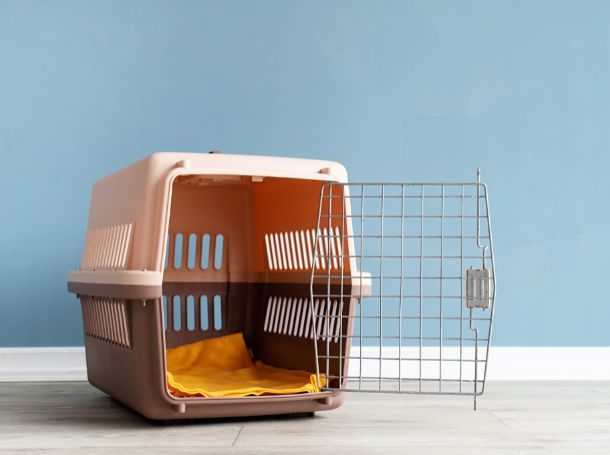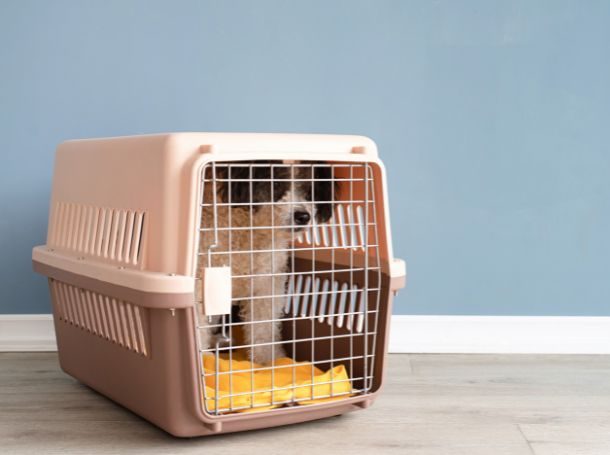
Puppy Crate Training at Night: The Ultimate Guide to a Peaceful Sleep
- March 19, 2025
Table of Contents
Crate training is an essential aspect of puppy ownership, especially when it comes to getting your puppy accustomed to sleeping at night. Many dog owners find themselves struggling with a puppy that cries, whines, or gets restless in their crate at night. But with the right techniques, you can make crate training a positive experience for both you and your puppy.
In this guide, we’ll explore everything you need to know about puppy crate training at night, from the basics to the most common issues and how to solve them. If you’re looking for more natural pet care tips, feel free to explore nature-inspired puppy training methods that emphasize calmness and comfort.
What is Crate Training?
Crate training is the process of teaching your puppy to feel comfortable and secure in a crate, which is often used as a sleeping space for your dog. It mimics the natural den instinct dogs have, providing them with a safe and cozy environment. Crates are also useful for house training, preventing destructive behavior, and giving your puppy a place to rest.
For crate training at night, the key is to ensure that the crate becomes a peaceful space for your puppy, not a place of anxiety or fear. Here’s why crate training can make your puppy’s nights more peaceful:
- Comfort and Safety: A crate offers a private space for your puppy to rest, much like a den in the wild.
- Routine and Structure: Puppies thrive on routine. A consistent bedtime routine can signal to your puppy that it’s time to sleep.
- Training Success: Proper crate training can help establish healthy sleeping habits and reduce nighttime anxiety.
Choosing the Right Crate for Your Puppy’s Night Training

The first step in successful crate training at night is choosing the right crate for your puppy. A crate that’s too small will be uncomfortable, while a crate that’s too large can encourage your puppy to use one corner as a bathroom.
Here’s what to consider when selecting a crate for nighttime:
- Size: The crate should be large enough for your puppy to stand up, turn around, and lie down comfortably. If you’re not sure which size to pick, most crate manufacturers offer size guides based on your puppy’s breed and weight.
- Material: Wire crates allow for ventilation, while plastic crates offer a more enclosed, den-like atmosphere. Soft-sided crates are portable but may not be as secure.
- Adjustability: Consider getting a crate with dividers to allow for growth as your puppy matures. This way, you won’t have to buy a new crate as your puppy grows.
Where Should You Place the Crate?
The location of the crate plays a crucial role in your puppy’s comfort at night. Puppies need to feel secure, so it’s essential to place the crate in a spot where they feel safe.
- Bedroom Placement: Many puppy owners choose to place the crate in their bedroom during the initial training period. This allows your puppy to feel close to you, which can reduce anxiety and help with the transition.
- Gradual Transition: Once your puppy is accustomed to the crate, you can gradually move it to a more permanent location, such as a living room or hallway.
- Avoid High-Traffic Areas: While puppies like attention, a noisy or busy area can interfere with their sleep. Choose a quiet, calm area for nighttime crate training.
How to Crate Train Your Puppy at Night: A Step-by-Step Guide
Now that you have the right crate and location, it’s time to start the training process. Here’s a step-by-step guide to help you with puppy crate training at night.
Introduce Your Puppy to the Crate
Start by introducing your puppy to the crate during the day. Use treats, toys, and positive reinforcement to help your puppy associate the crate with good things. Never force your puppy into the crate. Allow them to explore it on their own.Create a Calming Bedtime Routine
Puppies thrive on routine. Create a calming bedtime routine that signals to your puppy that it’s time to settle down. This might include a walk, a bathroom break, and some quiet cuddle time before crate time.Use Positive Reinforcement
Praise your puppy for entering the crate calmly, and offer treats when they settle inside. Positive reinforcement is essential for teaching your puppy that the crate is a pleasant place.Gradually Increase Crate Time
If your puppy isn’t used to being in a crate, start with short periods of crate time during the day and gradually increase the time. By the time nighttime comes, your puppy will be accustomed to being inside the crate.Be Patient on the First Night
The first night of crate training can be challenging. Your puppy may whine or cry, but it’s important to resist the urge to let them out immediately. This behavior is normal, and with consistency, your puppy will learn to settle down. If your puppy is excessively distressed, ensure their needs (like bathroom breaks or comfort) are met.
Common Problems and Solutions When Crate Training at Night

While crate training your puppy at night is effective, it can also come with its challenges. Here are some common problems and solutions:
Puppy Whining or Crying: It’s natural for puppies to cry when they first start crate training, especially at night. You can help by offering comfort and reassurance, but avoid picking them up immediately when they cry. Over time, they’ll learn that the crate is a safe and secure space.
Nighttime Potty Breaks: Young puppies have small bladders, and may need to go out for a potty break during the night. Take your puppy outside immediately if they start whining, but be careful not to make this a game. Keep things calm and quiet to avoid reinforcing bad habits.
Separation Anxiety: If your puppy is showing signs of separation anxiety, like excessive whining or drooling, you may need to increase crate training time during the day. Gradually increasing their time in the crate will help your puppy get used to being alone at night.
How Long Does It Take to Crate Train a Puppy at Night?
The duration it takes to crate train a puppy varies depending on the individual puppy, their age, and how consistently you follow the training process. Some puppies might adjust to sleeping in their crate within a few days, while others may take a few weeks.
Here’s a general timeline to expect:
- Week 1-2: Your puppy may cry or whine in the crate as they adjust to their new routine.
- Week 3-4: By now, your puppy should be sleeping in the crate with minimal fuss, especially if they’ve been gradually accustomed to it.
- Month 2: Most puppies are able to sleep through the night in their crate without significant issues.
Best Tips for Successful Crate Training at Night
Here are some additional tips to make puppy crate training at night a success:
- Use a Crate Liner: Make the crate more comfortable by adding a soft bed or crate liner. This will create a cozy, inviting space.
- Tire Your Puppy Out: Before bedtime, make sure your puppy has had plenty of physical and mental stimulation. A tired puppy will sleep better at night.
- Keep It Calm: At bedtime, keep things low-key. Avoid excitement, loud noises, or distractions that might disrupt your puppy’s sleep.
Conclusion
Crate training your puppy at night doesn’t have to be difficult. With patience, consistency, and the right approach, your puppy will soon associate their crate with safety and comfort. Follow the steps outlined in this guide, and before long, your puppy will be peacefully sleeping through the night in their crate.
Remember, crate training takes time, and every puppy is different. Be patient and persistent, and soon enough, your furry friend will enjoy a restful night’s sleep. If you’re interested in more natural and calming puppy care techniques, consider incorporating nature-inspired training methods into your routine to further enhance the comfort and well-being of your puppy.
Frequently Asked Questions (FAQs)
Gradually get your puppy accustomed to the crate, use positive reinforcement, and avoid letting them out immediately when they cry.
Start crate training as soon as you bring your puppy home, ideally at 8 weeks old, but the process will vary depending on your puppy’s age and temperament.
It’s generally best not to put food or water in the crate at night to prevent potty accidents. Make sure to provide water before crate time.
Young puppies typically need a potty break every 3-4 hours. As they grow, they can hold it for longer periods during the night.
Initially, it’s recommended to place the crate in your bedroom to help your puppy feel secure. Once they are comfortable, you can move it to another room.




Leave a comment